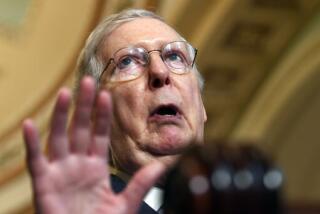That Budget Surplus Is Not a Done Deal
George W. Bush and Al Gore dispute what should be done with the projected “surpluses” in the federal budget. The disputes may or may not include “fuzzy math,” but both candidates’ projections are based on optimistic and unrealistic assumptions about the growth of the tax base. Sunshine today doesn’t guarantee sunshine tomorrow.
The optimistic assumptions are that the U.S. economy will continue the growth rate of the past decade and stay at full employment. The 1990s witnessed the longest cyclical expansion in peacetime history. During that expansion, growth in national income has been attributable to three factors: an increase in the working-age population; an increase in the participation rate, or the proportion of the working-age population that is employed; and an increase in productivity, or output per worker. While the level of employment and output per worker can be sustained in a healthy economy, I doubt that the growth rates of both can continue at the same rates as the past decade.
Unless it is offset by a further increase in immigration, growth of the working-age population will slow because of an increase in the labor force reaching retirement age. The growth in the participation rate over the last decade was largely attributable to the increased employment of married women and the movement from welfare to work. Further shifts will be smaller because almost everyone likely to work is now working. And productivity growth will continue to level off as it has over the last half century because of the shift in the composition of employment from higher-growth sectors, such as manufacturing, transportation and communications, to lower-growth sectors, such as health care and education.
The last decade’s high-growth sectors will continue to experience a decrease in their share of the labor force because with higher productivity it takes fewer workers to produce the same amount of goods. But health care and education are exhibiting negative productivity growth, largely because our accounting methods do not accurately measure improvements in health and learning. These are the sectors in which both candidates have promised to increase spending.
The basic principle is that our economic growth comes with once-over structural changes: Married women shift into the market labor force. Labor shifts out of lower-productivity sectors like agriculture into higher-productivity sectors like manufacturing. After the shifts have taken place, they can’t happen again. Further productivity growth must come within sectors. When the high-growth sectors decrease in relative size, the low productivity growth sectors, which remain constant or even increase in size, drag down the average.
Thus the national income growth rates on which the increased tax revenues and budget surpluses are projected by both candidates won’t continue even if the economy stays at full employment.
What about the “new economy”--low unemployment without inflation? Part of the reason for low inflation has been the strength of the dollar against foreign currencies as foreign capital has moved into the U.S. because of economic recession in Europe and Asia. As the world economy strengthens, the dollar is more likely to move down in foreign exchange value, and this will push up both domestic inflation and interest rates. This will pose the real test of whether the new economy can avoid rising inflation and interest rates, which will choke off growth and employment.
While voters deserve to hear the candidates’ priorities on taxes and spending, they should be skeptical about projected budget surpluses based on optimistic assumptions that are unrealistic.
More to Read
Get the L.A. Times Politics newsletter
Deeply reported insights into legislation, politics and policy from Sacramento, Washington and beyond. In your inbox three times per week.
You may occasionally receive promotional content from the Los Angeles Times.










